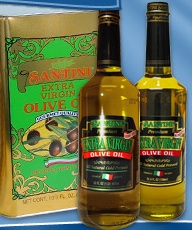
lion&globe, l
(article, Matthew Amster-Burton)
[%pageBreakSettings nobreak=true] Sure, I was as pleased as anyone when Crisco announced in January that all of its products were now officially free of trans fats. It was good timing, because a couple of weeks ago I found a lonely tub of old-school shortening on top of my fridge. While throwing it out, I started wondering: What's the difference between the various cooking fats, anyway? It's not their nutritional properties I have in mind; I'm as confused about this as anyone else. Everyone seems to agree that trans fats are a satanic plot, but beyond that, it's a morass. No, I'm thinking about dinner and how to choose the best fat for cooking it. [%image bottles width=350 float=right caption="Which oil to choose?" credit="Photo: iStockphoto/Silberkorn"] Here's what I can tell you. All fats contain a mixture of saturated, monounsaturated, and polyunsaturated fatty acids. You'll never cook with a pure saturated or unsaturated fat (though coconut oil comes close to being fully saturated), and this is a good thing. Saturated fatty acids make a fat firmer and less prone to rancidity. Too much saturation, though, and your fat will be too firm to work with comfortably and will leave your mouth coated with grease. Too little saturation, and the fat will perform poorly in pastry, oozing sadly into the flour; it will also turn rancid practically before your eyes. An example is flax oil, which is less than 10 percent saturated, has to be stored in a dark bottle in the fridge, and is useless for sautéing. Trans fats are a special category of unsaturated fatty acids that act like saturated fats and are produced during the hydrogenation process used to create vegetable shortening and shelf-stable lard. But even those products contain a mix of saturated and unsaturated (including trans) fatty acids. So the most important factor in how a fat performs in the kitchen is its fatty-acid profile, which is the egghead name for its mixture of saturated and unsaturated fatty acids. The other factor is flavor molecules, which dissolve in the fat. This is what makes corn oil taste like corn and peanut oil taste like peanuts — if you're lucky. The supermarket varieties of these oils are so refined that they don't taste like much of anything. Enough science class — let's get back to the kitchen. I can recall a time when my instinct was to reach for a bottle of vegetable (i.e., soybean) oil for everything from spaghetti sauce to stir-frying. Then I graduated to canola, partly because it was considered healthy and mostly because Ming Tsai used it on his show "East Meets West." There may have also been a time when I bought margarine in lieu of butter, but here my memory goes blissfully dark. Now, like everything else in my kitchen (spices, chocolate, Pepperidge Farm cookies), my cooking fats have multiplied. At the risk of turning this column into one of those "everything currently in my desk drawer" pages from the early days of the Web, I would like to share which fats I keep on hand and what I use them for, and speak up for lipid diversity in the kitchen. This week I'll discuss liquid oils; solid fats are up next. Unlike any other foodstuff I can think of other than vodka, most oils are sold on the basis of lack of flavor. I've never understood why this is considered a plus, when it's so easy to maintain a supply of high-quality oils whose natural flavors will complement a wide variety of cuisines. [%image santini float=left caption="Santini olive oils." credit="Photo courtesy Santini"] Olive oil. There's nothing I can tell you about olive oil that Jim Dixon didn't already explain in his recent article about the stuff. The extra-virgin I like for cooking, rather than drizzling, is Santini, sold at Trader Joe's. It's $7 a quart. The most expensive bottle of olive oil I ever bought was also Santini from Trader Joe's. I was driving the car and saw Trader Joe's coming up. "I'll stop in for some of that good, cheap olive oil," I said to myself. I was so lost in patting myself on the back for thinking of this that I plowed into the side of a brand-new SUV on the way into the parking lot. Peanut oil. There are three basic types of peanut oil on the market. One is the essentially flavorless oil sold at supermarkets, such as the Planters or Hollywood brands. It's expensive and not much different from canola. Next, there's the intensely flavored unrefined oil, which is a little cloudy and intolerant of high heat; this is a drizzling oil, like walnut or hazelnut oil. [%image lion&globe float=right caption="Lion & Globe peanut oil." credit="Photo courtesy Wing Yip Store"] But my favorite is somewhere in between: Lion & Globe cold-filtered peanut oil from Hong Kong. The aroma of this oil heating in the pan is one of my greatest pleasures in the kitchen: the promise that something delicious is in the offing. I turn to it for stir-fries, of course, but it's also suitable for deep-frying, or for all sorts of pan-fried flatbreads such as scallion pancakes. Plus, it can improve any store-bought frozen potstickers. You can find Lion & Globe at Asian groceries. Store it in the refrigerator; it'll turn opaque and thick (but generally still pourable), and will last much longer than at room temperature. Corn oil. I generally turn to lard (see my next column) for Mexican cooking, but for certain applications, nothing beats a good corn oil. That said, what I'm really thinking of here is salad dressing, not cooking. I'd like to find a corn oil that is the equivalent of Lion & Globe peanut oil: real corn flavor, but capable of withstanding sauté temperatures without smoking. If you know of such a product, please let me know. It would be great for, say, sautéing chicken and green-chile rajas for a taco filling. Canola oil. I keep a bottle of this in the fridge and it lasts quite a while, because I tend to use it when I want a thin film of oil across the surface of a pan. Why I don't use a can of PAM or some other oil for this purpose, I'm not sure. You're welcome to pry my canola oil from my lightly greased hands. [[block(sidebar). h1.Featured recipe ]] Did I leave out your favorite oil? Tell me about it. In the meantime, enjoy this recipe for broccoli. p(bio). [matthew.reviews@gmail.com "Matthew Amster-Burton"]* writes about cooking and culture from his home in Seattle. He keeps a blog titled Roots and Grubs.

lion&globe, l

santini, l

bottles, l

reference-image, l